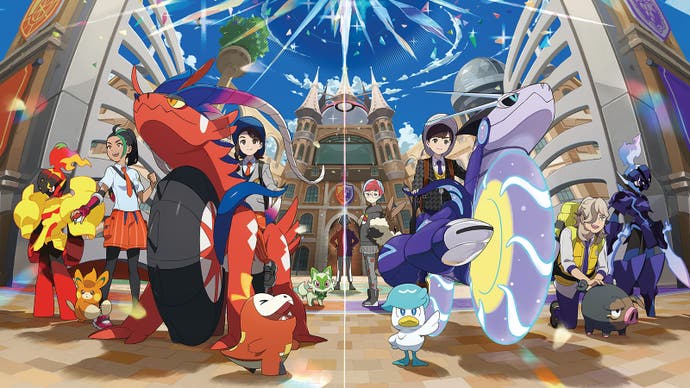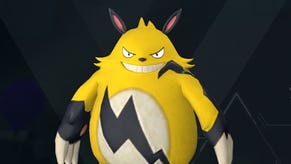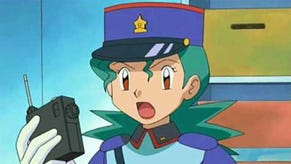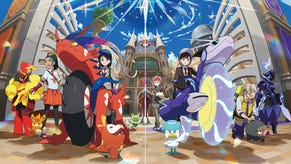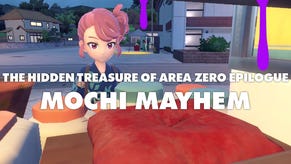Pok¨Śmon Scarlet and Violet review - the ambition is betrayed by the performance
From Paldea with love?
As a young fan, my dream Pokémon game contained three important features - returning to an old region like in Pokémon Gold, Silver and Crystal, destroying buildings with Mewtwo and escaping the chains of the route system, so I could explore a region to its very core. While I'm begrudgingly coming to terms with the fact that an instalment containing two regions may never occur again (still holding out hope for the Mewtwo dream), an open-world Pokémon game has finally arrived in the form of Pokémon Scarlet and Violet.
Gone are the days of neatly organised routes funnelling you from Gym to Gym, for, after completing the games' opening chapter, you're free to venture anywhere. Paldea is the largest region the series has seen so far - ranging from green fields to a windswept desert to a bamboo grove - and, upon leaving the city of Mesagoza for the wilds, it does feel like you're on the cusp of a grand adventure.
All of the locations you can glimpse in the distance are reachable and, while you can set a destination on the overworld map, the mini-map will only show a marker pointing in its direction. How you reach your destination is up to you; creating the sense of carving out your own journey, rather than following a set path like in previous Pokémon titles. Though you will often find yourself being distracted by the siren call of a new Pokémon to catch or an item to collect and, before you know it, you're wandering through a new location.
Navigating Paldea never feels like a chore either, in part thanks to your legendary Pokémon mount - Koraidon in Scarlet and Miraidon in Violet - allowing you to travel faster and to places your little human legs could never reach. You'll gradually unlock the ability to climb cliffs, swim up rivers and glide down from mountain peaks on this Pokémon's back. Koraidon and Miraidon are, effectively, the embodiment of HMs in Scarlet and Violet. Though, sadly, Strength is not part of their arsenal. The result is that none of Paldea's incredibly brown caves hold the same complexity as those found in past games, like the Seafoam Islands or Mount Coronet. But, by utilising the legendaries' other abilities, these areas at least avoid the corridor-like nature of the caverns in Sword and Shield.
Outside of travelling, there's a selection of mechanics which assist you in Paldea; from making sandwiches, which provides useful boosts such as increased XP or extra power in raids for specific types, to Auto-Heal - a little feature I really came to appreciate due to how it cuts down on menu hopping, healing my Pokémon from the team list instead. Most notably, there's the Let's Go mechanic where you send out your leading Pokémon to gather items and automatically battle wild Pokémon. Not only does this help grind Pokémon levels, since you don't have to physically take part in the battles, it also makes gathering materials - such as fur, mucus and, of course, flaps - for crafting TMs easier. While TMs can still be found in the wild, presumably abandoned by forgetful trainers, crafting these items negates the worry of teaching a Pokémon an attack, only to realise it suited another's moveset far better.

One of the greatest tools in any Pokémon trainer's disposal, however, is the Pokédex. My love for the Pokédex in Scarlet and Violet doesn't just stem from how it resembles a bookshelf. The photographs are a welcome addition to the Pokémon models, but, best of all, it's been perfectly adapted for the games' open-world nature without losing any of the surprise that comes from discovering a new Pokémon.
As you battle and catch new Pokémon, the Pokédex collects notes; sometimes it's on a Pokémon connected to the new creature, such as an evolution, but, other times, there's no connection at all. Either way, while the note doesn't reveal its type or name, it will display the Pokémon's silhouette and, more importantly, its location. This is an excellent way to encourage exploration or hint at a Pokémon you might have missed, especially since the Pokémon radar only tells you which ones are nearby, not their exact locations. You can still experience the thrill of the hunt.
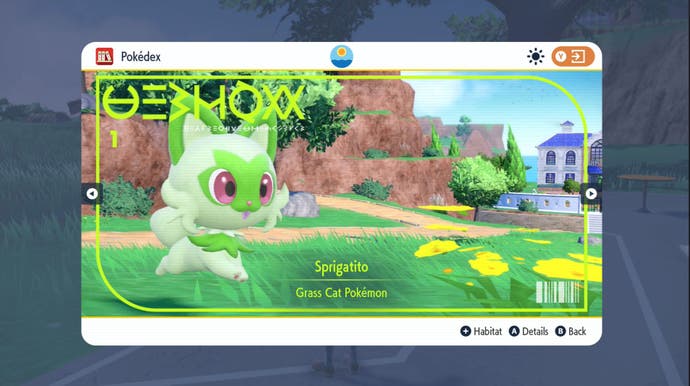
Unfortunately I can't, for spoiler reasons, delve as deep as I'd like into the new Pokémon of Gen 9. Without giving too much away, there's a good variety of designs in both terms of appearance and type combinations, including some we've never seen before, like Grafaiai's poison and normal typing. There have been a few which have made me think, 'What? Why?' Along with one who may take the title of being my most loathed Pokémon from the dreaded Binacle.
On a more favourable note, I love Armarouge, who can be trained into the perfect critical hitter. I love how you can see Greavard's candle glowing in the dark before it jumps out of the ground. And, I'll admit, I want to know what Fidough tastes like. Regional Pokémon, like Paldean Wooper, also make a welcome return, but what really caught my interest were Pokémon like Wiglett - creatures that look like they're regional variants, yet are, in truth, their own species. Like the extinct Pokémon of the Hisui region, they add another layer to this universe, revealing that the history of Pokémon is far more complex than we realise.
Aside from Gen 9, Scarlet and Violet also introduces a new battle mechanic in the form of Terra Types. Activated via the Tera Orb, this will transform your Pokémon into a crystal-like figure adorned with a crown representing its Tera Type - statues of which will surely be for sale on the Pokémon Center site for years to come.
Every Pokémon has a Tera Type - for single type Pokémon it will usually match their type, while, for dual types, it will be their primary type. Armarouge, for example, will typically have a fire Tera Type despite being a fire and psychic Pokémon. You can eventually change a Pokémon's Tera Type through the use of Tera Shards, but, if you want to start experimenting with this new mechanic as soon as possible, it's better to venture out in the wild. Here you can occasionally encounter Terastallized Pokémon, whose Tera Type might surprise you, or partake in Tera Raids. These raids operate in a very similar manner to those in Sword and Shield; the main differences being the Pokémon are Terastallized and cheering, which grants stat boosts or heals your Pokémon.
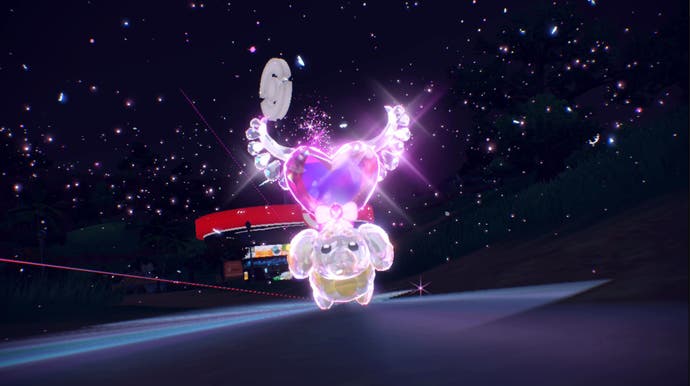
After using the Tera Orb - referred to as Terastallizing - the Pokémon's type will change into its Tera Type. In doing so, moves categorised under this Tera Type will become more powerful, while others - and certain abilities - will change. This creates a range of strategic possibilities. Do you build a Pokémon's moveset around its Tera Type or do you change it in the hope of surprising your opponent? Matters are further complicated by two facts: the first being that you won't know a Pokémon's Tera Type until it's activated and, secondly, the Tera Orb can only be used once before it needs recharging. With these rules in mind, you face a new conundrum - when do I Terastallize my Pokémon? When my opponent does or, do I wait? All of these factors combine to make Tera Types a compelling mechanic, which can be as intensive as you want it to be. You could use Terastallizing to simply boost attack power or search Paldea for the Tera Shards required for giving your Pokémon the perfect Tera Type.
Yet to give Paldea its size, both physically and mechanically, Scarlet and Violet has had to sacrifice its depth. Despite the numerous buildings you'll see, you can barely enter any, and you most definitely can't scour through people's trash. Trust me, I've tried. If you could get a concussion from running face first into doors in these games, my avatar would be in a coma.
Most of the buildings you can enter are shops and, even then, you're met with a menu screen. It's one you'll quickly memorise too, because the same shops and restaurants are present across Paldea. Some even appear multiple times in the same city. There is one recurring sandwich shop which has been deemed worthy of an interior, but, still, I miss the snapshots I used to get from wandering into people's homes and learning about how they live alongside Pokémon. It's an element of immersion that Scarlet and Violet severely lack, because, instead of being bustling settlements, the towns feel like they're constructed out of the shoe box castles I made as a child - slightly pretty on the outside, hollow on the inside.
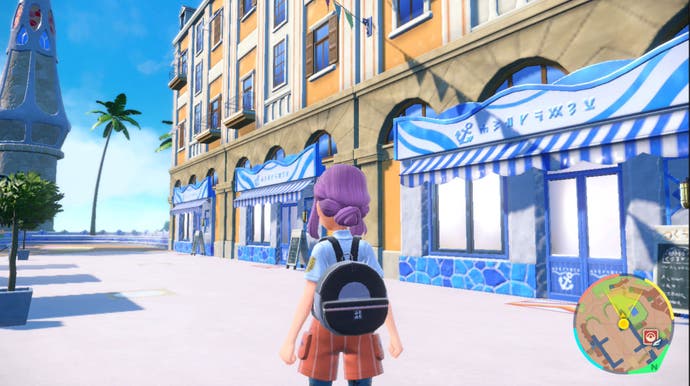
The populace of Paldea haven't fared much better. While the towns do feel full of people - with NPCs wandering down the roads or sitting on a bench with their Pokémon - barely any have something to say. Those who can talk are divided into two categories: white chat boxes, where the speaker only has surface level dialogue, and golden chat boxes, which means the character offers some kind of feature, be it a trade or useful item. While this differentiation does save time, it's a disappointing realisation that I've gone from heavily exploring a town, chatting with every local in hopes of uncovering their secrets, to ignoring anyone who hasn't been gilded with gold.
There has been an attempt to bring life to the school you attend - Naranja Academy in Scarlet and Uva Academy in Violet. Here you can take lessons on the game's mechanics and even delve into the history of Paldea; in doing so you befriend the teachers and even unlock rewards from helping them with their troubles. The school is one of the only places where it truly feels like you get to know Paldea, which is helped by how it's interwoven into one of the storylines.
Yet, this atmosphere is undercut by how easy it is to forget the school exists once you're free to roam. It's a symptom of how the idea of giving this world a richness, making it feel lived in, has been left by the wayside. Outside of the Academy, the only town I felt any delight in visiting was Alfornada, and that's because sprites from Pokémon Red, Green, Blue and Yellow were incorporated into its design! It makes me wonder if having multiple towns in Paldea was even necessary; Mesagoza could have been a hub city, similar to Jubilife Village in Pokémon Legends: Arceus, the Gyms isolated spots reached only by bracing the deepest parts of the Pokémon-infested wilderness.

What does work in Scarlet and Violet, however, is the level scaling. Paldea is divided up into a collection of named locations, such as the Asado Desert and Glasedo Mountain, towns and four Provinces - one for each cardinal direction. These Provinces are then divided into a set of Areas; the majority have three Areas, the exception being the South Province which has six. Each Area has been assigned a number that indicates the strength of the wild Pokémon who inhabit it, since their levels often rise alongside said number. Named locations, meanwhile, share the level range of a nearby Province Area, but there are places where the level will jump quite significantly, so watch out! When it comes to the Gym Leaders and trainers, you can expect their parties' levels to reflect the wild Pokémon in the Area or location they're within, so, if you're in an Area containing Pokémon ranging from Level 30 to 35, you can expect any Trainer you encounter to have similarly levelled Pokémon.
Scarlet and Violet's level scaling is a good reimagining of the traditional 'higher route number equals stronger Pokémon' system, because it merges the principle of the further you travel from a game's starting location - in this case, Cabo Poco on the south Paldean coast - with the games' open world design. Many of the Pokémon you encounter will still provide an enjoyable challenge, ensuring the gradual growth of your team. (Unless visiting north Paldea is your first goal and, if so, I wish you luck.) Yet, you still have a sense of trepidation every time you enter a new location, because, while you can see the Pokémon, you don't know whether they can grind you into dust unless you enter a battle. A number of times I found myself merrily walking into a new area only to run away as quickly as possible, because to stay would mean death.
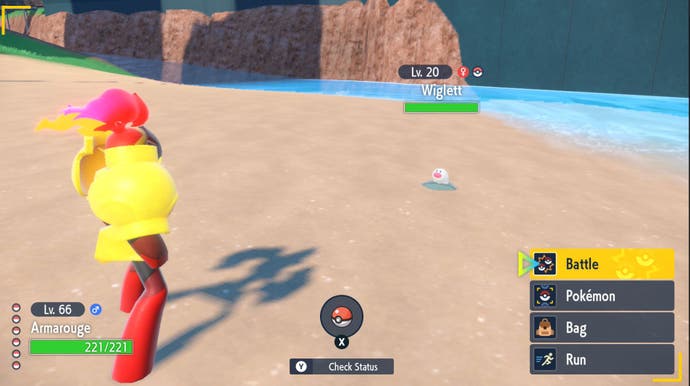
The non-linearish approach to storytelling in Scarlet and Violet also suits its open-world design. I say non-linearish, because you can't run into the Pokémon League with just your Level 5 starter Pokémon or skip over certain events entirely to reach the end of the main campaign. Instead, you're free to move between the storylines - Victory Road, Starfall Street and Path of Legends - tackling the events within them in any order you please. The games do try to railroad you into defeating a Team Star crew at one point - blocking a road until you tackle the nearby base - but you can easily avoid it by using geography to your advantage and, by that, I mean jumping off a cliff. Don't worry - your Rotom phone will break your fall. I found myself regularly switching between the storylines; figuring out which activities would challenge my team's strength or lay in parts of Paldea I was yet to visit. It always felt like I was an active participant, weaving the story beats of my adventure together, unlike Sword and Shield where you were akin to a bystander during important events.
When it comes to the storylines themselves, Victory Road is your standard 'Become the Pokémon Champion' affair anyone who's ever played a mainline Pokémon game will be accustomed with. Though you're free to tackle any Gym Leader, their team's levels are set, meaning there is an ideal order for collecting the Gym Badges. Aside from the first Gym, however, the games don't outline this order for you and, while you can figure it out, it's more fun to craft a bespoke journey to the Elite Four.
Gym Tests do make a return mostly in the form of small challenges occasionally intercut with a trainer battle. None of them take long nor are very challenging, but they provide an enjoyable build up for the Gym Leader battles. What I do miss are the Gyms themselves as, while you can enter them, you'll always be met with the same grey tiled lobby. Gone are the interesting designs inspired by the Leader's chosen type, like swimming pools for a water-type Leader or a haunted castle for one who prefers ghosts. You even fight every member of the Elite Four in the same bland room. Instead, both the Gym Tests and Leader battles take place outside and, though there is a satisfaction in demolishing a figurehead in the centre of town, I did find myself longing for the gyms of old.
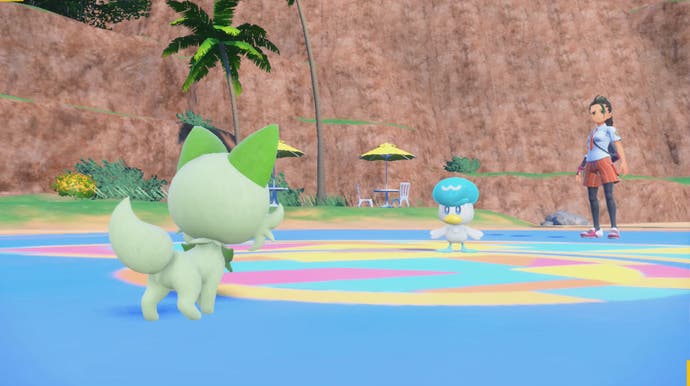
Path of Legends and Starfall Street are shorter when compared to Victory Road, yet both provide a welcome change from the typical flow of a Pokémon game. In Path of Legends you assist Arven in finding, and battling, the Titan Pokémon of Paldea. The Titans themselves act like mini-bosses with their exact levels being hidden. This design decision adds a sense of danger at the beginning of each battle, as you never know how powerful the Pokémon towering above you is.
Starfall Street, meanwhile, tasks you with raiding the Team Star bases scattered about Paldea to stop the students within from skipping school. (Teams in past Pokémon games may have sought world domination and incredibly misguided environmental changes, but clearly this is the greatest crime of all.) Each base is, like the Gyms, themed around a type and, after you've gained entry, you'll have 10 minutes to defeat 30 Pokémon using the Let's Go feature. While a novelty at first, battling Team Star in this manner quickly becomes tedious and, eventually, I was wishing I could just skip to the boss battle.

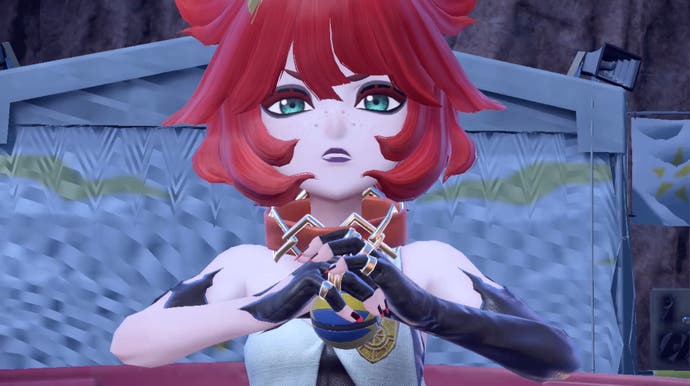
The downside of these storylines is, like Victory Road, they both follow a formula: visit a new location, battle either the Titan or Team Star, collect your reward, move on. Their redemption, however, lies in their narratives. While I don't want to spoil too much, I will say Arven has one of the sweetest stories the game has seen so far. Meanwhile, Team Star's plot reveals itself to be an interesting tale about misconceptions, bullying and the lengths people will take to protect themselves from it.
None of this, however, can escape the true arrow in Scarlet and Violet's side - the graphics and performance issues. At this point, saying the graphics in Pokémon games are disappointing feels akin to moaning about water being wet. Yet there are clearly locations which are meant to inspire awe, and where the graphics prevent this feeling from ever manifesting. Despite the bright colours, Paldea has an inescapable blandness brought about by the basic textures and how, in many places, there's been no attempt to blend their transitions together, leaving you staring at the perfectly straight line between rock and grass.
The gameplay may be enough to distract you from the graphics, but what it can't hide are the framerate drops. You'll be exploring a new Province when, suddenly, your avatar will visibly slow down or you'll spot the stilted turn of a windmill, which leaves you wondering if Windy Miller coated its gears in tar. The framerate drops are most evident in the towns where, unless you're standing next to them, NPCs walk like they're in a bad stop-motion film. Sometimes this can result in them being trapped inside their Pokémon companion or another person, creating a body horror moment usually reserved for the darkest of Pokédex entries.

Not to forget the other graphical glitches which persist in the 1.0.1 patch. I would be fully immersed in the game only to have an opponent's face flicker uncontrollably, scenery jump into existence or, during a victory celebration, have the ground clip out from beneath my feet. During these moments, it was like I'd been grabbed by the scruff of my neck and given a good shake. The fact is Pokémon is a franchise which has the wealth - both in time and money - to fix these issues and, when they're ignored, it sullies the overall quality of the games.
In the end, I left Paldea feeling conflicted. I like the open-world gameplay, especially the level scaling, and new Pokémon, but they're entangled with a region which, despite its size, always feels slightly empty, and they're presented in graphics we know are beneath the Nintendo Switch's top performance. If more time and polish had been applied to Scarlet and Violet, then they could have lived up to their ambition and been the expansive world many fans, myself included, have dreamed of. Yet the Pokémon series has a schedule to follow and it waits for no Slowpoke.
